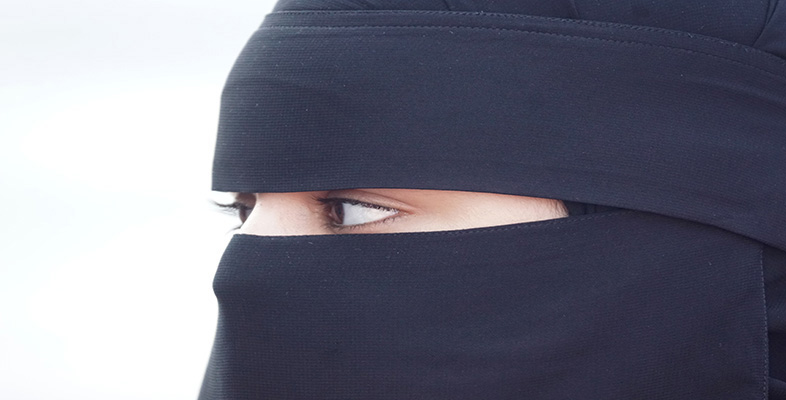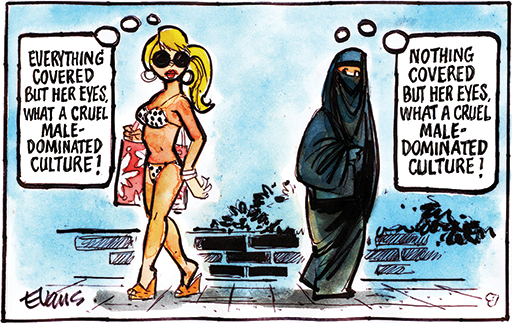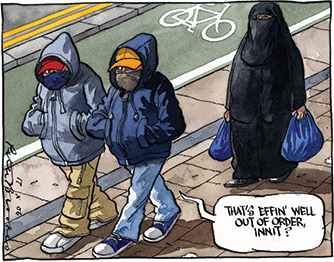The veil as symbol of empowerment or oppression?
Activity 5
Have a look at Figures 4 and 5. Figure 4 is a cartoon that was originally published in newspapers in New Zealand (the Christchurch Press, the Timaru Herald and the Manawatu Standard) in January 2011. Figure 5 is a cartoon that was published in October 2006 in The Times.
- What does Figure 4 tell us about different perceptions of the burqa and the bikini, and about their association with the oppression or empowerment of women?
- How do you interpret the view of the ‘hoodie’ youths in Figure 5?
Discussion
- The two women shown in Figure 4 adopt radically different dress codes. One of them is scantily clothed in a bikini, high heels and sunglasses, while the other is wearing a black cloak covering her whole body and face – in other words she is wearing a burqa. As becomes apparent in their ‘think bubbles’, each woman regards the other as oppressed and as a victim of a ‘cruel male-dominated culture’. This cartoon highlights that it is not just the burqa that is often stereotypically associated with the oppression of women. Revealing dress codes which women are encouraged to adopt as part of ‘western’ secular mainstream culture can also be regarded as oppressive (not just by Muslims), and as a sign of the sexual exploitation and objectification of women because they put so much emphasis on physical charms and sex appeal, rather than on personality or intelligence. It also becomes apparent that neither of these two women perceives herself as oppressed; rather, each feels liberated from the constraints of the ‘male-dominated culture’ that appears to oppress the other woman.
- In Figure 5 hoodie-wearing youths express their dismissive opinion of a burqa, but seem to be blissfully unaware of the fact that their hoodies are actually remarkably similar to the burqa in terms of the way they cover their bodies and faces and are perceived controversially by many members of society – though for reasons that are different from those that lie behind the perception of burqas.
There are many different social, political, cultural and geographical factors that can influence why Muslim women adopt particular styles of veiling or do not wear a veil at all. Contrary to Shaheed’s claim in Reading 2 that ‘religious’ factors often play only a minor role in the adoption of different styles of veiling, many Muslim women stress their religious motivations. Tarlo notes that supporters of the niqab often highlight the spiritual benefits of the sense of physical closure it creates: ‘The sense of physical closure attained by the face veil operates both outwards and inwards. It has the effect of people turning in on themselves, enabling them to concentrate more fully on issues of self-discipline, self-restraint, self-mastery, devotion and prayer’ (2010, p. 151).
However, can ‘religious’ motives ever be neatly separated from politics, culture or geography? Are they not inevitably closely intertwined? It is clear that there are many contrasting points of view on the issue of veiling within Islam, and many different motives behind the adoption of different veiling practices. For some, the adoption or rejection of different styles of veiling makes them ‘unwilling targets of attention’, while others use veils as part of a ‘self-chosen visible declaration of their identity and faith’ (Tarlo, 2010, p. 1). The adoption of the niqab has been particularly controversial. Based on her analysis of forum discussions on Islamic websites, Tarlo comes to the conclusion that there are many disagreements on this issue among Muslims and that the niqab ‘has both male and female critics and supporters’ (2010, p. 150). Tarlo notes that a common theme ‘in discussions concerning niqab is the conflict between those emphasizing an individual’s religious path or duty and those more concerned with the wider social implications of niqab wearing’ (2010, p. 149).
The case studies explored in this section also highlight the fact that women can change their approaches to veiling practices at various points in their lives, adopting a range of veiling practices and investing them with different meanings in different contexts or situations. In Reading 2 Shaheed gives the example of her grandmother, who temporarily adopted the burqa to enable her to attend university. This example also demonstrates that the adoption of the hijab can open up choices and opportunities for Muslim women and can facilitate access to public space, education and work. It can enable Muslim women to observe notions of modesty without having to radically limit the range of activities they pursue outside their homes. Nevertheless, veiling practices can still pose a range of practical challenges.


